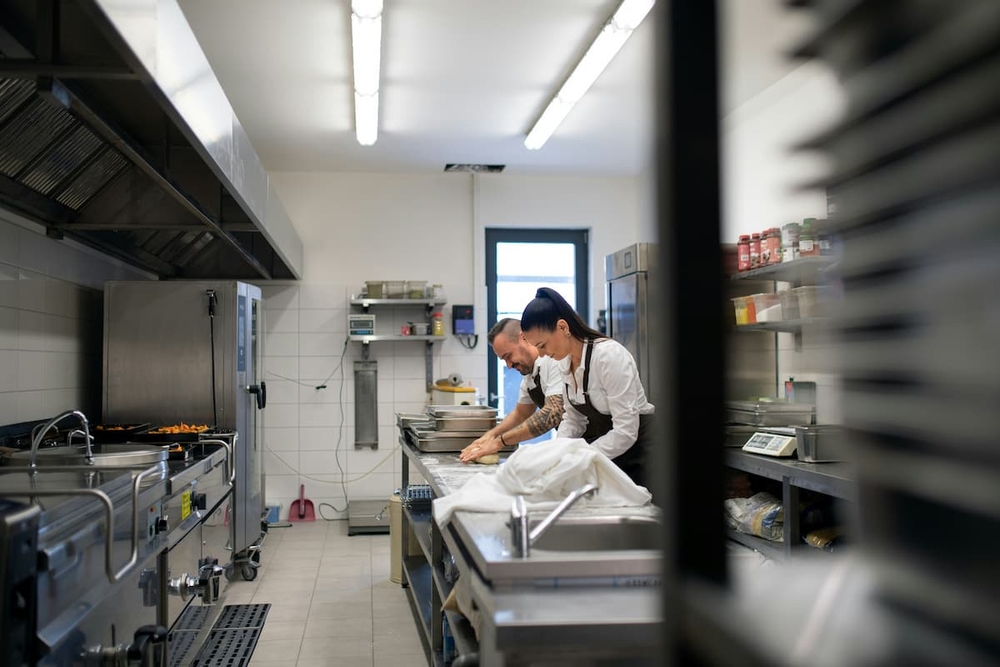Why Bulk Production Kitchens are Essential for Expanding Demand for Asian Cuisines?
Table of Contents
CloudKitchens
How many tacos can be delivered from a 1000sqft restaurant?
The same amount as a 200sqft ghost kitchen.
Asian cuisine has taken the global food scene by storm. From the umami depth of Japanese ramen to the fiery spice of Szechuan stir-fries, the demand for authentic Asian dishes continues to surge across the U.S. and beyond.
However, meeting this demand is not as simple as scaling a typical restaurant operation. Bulk production kitchens offer an ideal solution to help businesses keep up while maintaining the authenticity, complexity, and consistency that Asian cuisine demands.
In this guide, we’ll explore the importance of bulk kitchens for Asian cuisine, the operational challenges these cuisines present, the must-have equipment and so on!
The growing popularity of Asian cuisines
Asian cuisine has rapidly grown in popularity over the last decade. According to a report from the National Restaurant Association, Asian cuisines were among the fastest-growing food categories in the last years, with Korean, Thai, and Japanese leading the trend.
Several factors contribute to this:
- Rising consumer interest in global flavors;
- Greater accessibility to Asian ingredients;
- Health-conscious eating trends favoring dishes like sushi and pho;
- An increase in Asian-American populations influencing mainstream culture;
- Influence of Asian culture around the world.
Read more: How to create a successful chinese food delivery business: a complete guide
Why traditional kitchens struggle with Asian food demand
Unlike typical Western dishes, many Asian foods involve intricate, multi-step preparation methods:
- Marinades requiring long soaking times;
- Stir-frying in specialized equipment like woks;
- Dumpling folding and noodle pulling by hand;
- Delicate balancing of sweet, spicy, savory, and umami flavors.
This complexity makes scaling operations challenging for a traditional kitchen. Without sufficient prep space, specialized tools, and efficient workflows, it’s hard to maintain the authenticity that customers expect.
Read more: Your guide to opening a Korean kitchen for delivery success
How bulk production kitchens solve the problem
Bulk production kitchens can help bridge the gap between demand and supply without compromising quality. Here’s how:
1. Centralized production for consistency
Asian cuisine relies heavily on consistency — one wrong ratio in a sauce can alter the entire flavor profile. Bulk kitchens allow you to centralize production of broths, sauces, dumplings, and marinades in controlled environments, ensuring every dish remains authentic.
2. Increased capacity to meet high volume
With a bulk kitchen, you can prepare hundreds (even thousands) of portions per day. This is critical during peak times such as Lunar New Year, Diwali, and other cultural celebrations, when demand skyrockets.
3. Specialized equipment setup
Bulk production kitchens allow operators to invest in specialized equipment essential for Asian cooking, such as:
- High-BTU wok burners;
- Rice cookers for large volumes;
- Commercial-grade bamboo steamers;
- Large stock pots for broth-based dishes;
- Specialized noodle cookers.
According to Otao Kitchen, commercial Asian cooking setups often require twice the amount of burners and prep space compared to typical Western kitchens.
Read more: Essential guide to industrial kitchen equipment for ghost kitchens
4. Efficient staffing and workflow design
With a dedicated bulk production facility, you can organize staff into specialized teams:
- Dumpling teams;
- Soup and broth preparation teams;
- Grill and stir-fry stations;
- Packaging and delivery teams.
This specialization boosts productivity and allows for high-quality control even during high-demand periods.
Read more: The power of unique food packaging in customer experience
5. Easier compliance with food safety standards
Handling raw meats, seafood, and complex sauces in high volume requires strict food safety protocols. Bulk kitchens are designed to comply with regulations more easily, providing proper refrigeration, separate prep areas, and ample storage.
Must-have equipment for bulk production of Asian cuisine
Asian culinary traditions require specific tools and setups that bulk kitchens can support. Some must-haves include:
- Commercial wok ranges: For high-heat stir-frying
- Steamers: Essential for buns, dumplings, and dim sum
- Stockpot burners: For large batches of broth
- Blast chillers: To quickly cool hot foods for safe storage
- Sushi refrigerators: To maintain ideal temperatures for raw fish
- Rice warmers: To hold cooked rice at the perfect serving temperature
A good Asian restaurant thrives on outstanding culinary skill, a sophisticated dining atmosphere, and an unwavering dedication to quality. This means sourcing the finest ingredients, employing expert chefs with deep knowledge of regional flavors, and crafting an environment that elevates the entire dining experience.
Read more: When is the right time to scale to a high-volume kitchen?
The role of ghost kitchens and delivery in expanding Asian cuisine
Ghost kitchens are particularly well-suited for expanding Asian cuisine brands. Here’s why:
- Asian foods like sushi, dumplings, ramen, and pad Thai are highly delivery-friendly.
- Delivery demand for Asian cuisine is robust year-round.
- Operators can launch multiple brands from a single bulk production hub (e.g., one brand for ramen, another for Korean fried chicken).
- Flexibility to test new dishes quickly based on local demand.
A 2023 DoorDash report found that Asian dishes made up 26% of their total food delivery volume in the U.S. — a huge opportunity for ghost kitchen operators.
Read more: How shared kitchens help reduce overhead costs for food businesses
Popular Asian dishes that benefit from bulk production
Some of the top Asian dishes ideal for centralized production include:
- Ramen and pho broths;
- Dumplings (xiao long bao, gyoza);
- Banh mi sandwich components;
- Korean BBQ marinades;
- Kimchi;
- Sushi rice and rolls;
- Stir-fried noodle dishes (pad Thai, chow mein);
- And much more!
These dishes involve labor-intensive prep that scales much more efficiently in bulk settings.
Challenges to watch for in bulk production
Even with all the benefits, bulk production kitchens come with challenges:
- Maintaining freshness: Asian cuisine emphasizes fresh ingredients, so cold storage and quick turnover are essential.
- Complexity of menu: Too large a menu can slow production and reduce efficiency.
- Staff training: Properly training cooks on authentic techniques at scale requires time and attention.
Mitigating these challenges with smart kitchen design, scheduling, and quality controls is key.
Read more: Scaling up food production for growth and efficiency
Scaling Asian cuisine smartly with bulk production kitchens
The surge in demand for Asian cuisine shows no signs of slowing down. But traditional restaurant setups often can’t keep pace with operational demands while maintaining authenticity. Bulk production kitchens offer a solution — allowing restaurateurs, caterers, and entrepreneurs to meet growing customer expectations, expand their brand presence, and do so in a cost-effective, sustainable way.
Are you ready to expand your Asian food business without compromising on quality? Partner with CloudKitchens for smart, flexible kitchen solutions designed for high-volume, high-quality production. Contact us today and start growing your brand the right way!
DISCLAIMER: This information is provided for general informational purposes only and the content does not constitute an endorsement. CloudKitchens does not warrant the accuracy or completeness of any information, text, images/graphics, links, or other content contained within the blog content. We recommend that you consult with financial, legal, and business professionals for advice specific to your situation.
More insights & stories
There’s more where that came from.
Get in the know and check out our additional insights


